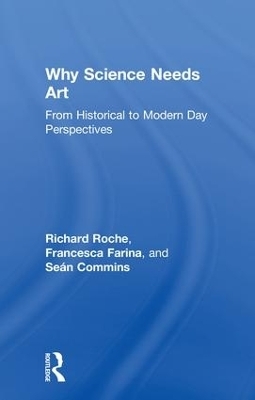
Why Science Needs Art
From Historical to Modern Day Perspectives
Seiten
2018
Routledge (Verlag)
978-1-138-95922-4 (ISBN)
Routledge (Verlag)
978-1-138-95922-4 (ISBN)
Why Science Needs Art explores the complex relationship between these seemingly polarised fields. Reflecting on a time when art and science were considered inseparable and symbiotic pursuits, the book discusses how they have historically informed and influenced each other, before considering how public perception of the relationship between these disciplines has fundamentally changed.
Science and art have something very important in common: they both seek to reduce something infinitely complex to something simpler. Using examples from diverse areas including microscopy, brain injury, classical art, and data visualization, the book delves into the history of the intersection of these two disciplines, before considering current tensions between the fields. The emerging field of neuroaesthetics and its attempts to scientifically understand what humans find beautiful is also explored, suggesting ways in which the relationship between art and science may return to a more co-operative state in the future.
Why Science Needs Art provides an essential insight into the relationship between art and science in an appealing and relevant way. Featuring colorful examples throughout, the book will be of interest to students and researchers of neuroaesthetics and visual perception, as well as all those wanting to discover more about the complex and exciting intersection of art and science.
Science and art have something very important in common: they both seek to reduce something infinitely complex to something simpler. Using examples from diverse areas including microscopy, brain injury, classical art, and data visualization, the book delves into the history of the intersection of these two disciplines, before considering current tensions between the fields. The emerging field of neuroaesthetics and its attempts to scientifically understand what humans find beautiful is also explored, suggesting ways in which the relationship between art and science may return to a more co-operative state in the future.
Why Science Needs Art provides an essential insight into the relationship between art and science in an appealing and relevant way. Featuring colorful examples throughout, the book will be of interest to students and researchers of neuroaesthetics and visual perception, as well as all those wanting to discover more about the complex and exciting intersection of art and science.
Sean Commins, Richard Roche, Francesca Farina
Foreword, Introduction, When Art and Science were One: Leonardo da Vinci, Art under the Microscope: Cajal and Golgi, The Brain’s Signature: Visual Art in Normal and Abnormal Brains, A Thousand Data Points: Art in Scientific Visualisation, Neuroaesthetics: Two Roads Converge, Conclusion
| Erscheinungsdatum | 26.10.2017 |
|---|---|
| Zusatzinfo | 54 Halftones, black and white |
| Verlagsort | London |
| Sprache | englisch |
| Maße | 138 x 216 mm |
| Gewicht | 317 g |
| Themenwelt | Kunst / Musik / Theater ► Kunstgeschichte / Kunststile |
| Geisteswissenschaften ► Psychologie ► Allgemeine Psychologie | |
| Geisteswissenschaften ► Psychologie ► Entwicklungspsychologie | |
| Geisteswissenschaften ► Psychologie ► Verhaltenstherapie | |
| ISBN-10 | 1-138-95922-7 / 1138959227 |
| ISBN-13 | 978-1-138-95922-4 / 9781138959224 |
| Zustand | Neuware |
| Haben Sie eine Frage zum Produkt? |
Mehr entdecken
aus dem Bereich
aus dem Bereich
Buch | Softcover (2024)
Hogrefe Verlag
CHF 46,50
wie Affekte innere Entwicklung ermöglichen
Buch | Softcover (2023)
Klett-Cotta (Verlag)
CHF 41,95


